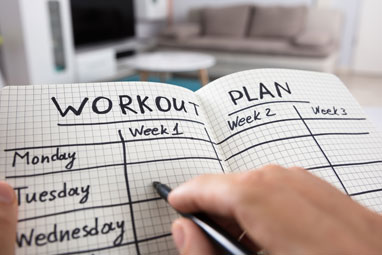Along with proper meal planning, taking medications as prescribed, and stress management, your diabetes doctor in Los Angeles will advise you that regular aerobic and weight bearing exercise can help control the symptoms of diabetes. Aerobic exercise in particular can also help prevent the onset of type II diabetes.
How Aerobic Exercise Helps Control Diabetes
Aerobic exercise:
- improves your body’s use of insulin
- makes your heart strong
- strengthens bones
- provides stress relief
- improves circulation
- reduces your risk of heart disease by lowering blood glucose and blood pressure while improving your cholesterol levels
Goal: Aim for 30+ minutes of moderate-to-intense aerobic activity at least five days per week. Try to never go more than two days in a row without exercising.
Tips:
- If you haven’t been active lately, just start out with five-ten minutes per day, then build up to your goal of 30 minutes per day.
- If you are also trying to lose weight, you will need to up your exercise to 60 minutes per day.
- Working out in 10- or 15-minute intervals throughout the day adds up to success! If you daily total is 30 (or 60) minutes, you will have still met your goal.
How Strength Training (Resistance Training) Helps Control Diabetes
Strength (or Resistance) Training:
- Makes your body more sensitive to insulin and can lower blood glucose.
- Helps to maintain and build strong muscles and bones, reducing your risk for osteoporosis and bone fractures.
- The more muscle you have, the more calories you burn – even when your body is at rest.
- Prevents muscle loss and is the key to maintaining an independent lifestyle as you age.
Goal: Aim to do some type of strength training at least two times a week, in addition to your aerobics.
Tips:
- If you don’t belong to a gym with weight machines, you can still use hand-held weights, resistance bands, or your own body weight to build muscle.
- It’s a good idea to work with a certified trainer at first, so you can learn the correct way to do the exercises.
- Don’t work the same muscle group two days in a row – give your muscles a chance to recover!
- Always warm-up before you exercise.
How to Get Started with a Diabetes-Friendly Exercise Plan
Make a List of Activities that Sound Fun!
Anything that raises your heart rate – or builds muscle—counts! You can include on your list activities that you have enjoyed in the past and haven’t done in a while, or things you have always dreamed of doing. Try searching the internet for the latest workout trends, too – you just might find something intriguing! You can also ask your diabetes doctor in Los Angeles, Dr. Gura, what he recommends.
Some popular ideas (from the American Diabetes Association) include:
Aerobics:
- Brisk walking (outside or inside on a treadmill)
- Bicycling/Stationary cycling indoors
- Dancing
- Low-impact aerobics
- Swimming or water aerobics
- Playing tennis
- Stair climbing
- Jogging/Running
- Hiking
- Rowing
- Ice-skating or roller-skating
- Cross-country skiing
- Moderate-to-heavy gardening
Strength/ Resistance Training
- Weight machines or free weights at the gym
- Using resistance bands
- Lifting light weights or objects like canned goods or water bottles at home
- Calisthenics or exercises that use your own body weight to work your muscles (examples are push-ups, sit ups, squats, lunges, wall-sits and planks)
- Classes that involve strength training
- Other activities that build and keep muscle like heavy gardening
Get an “OK” from your Diabetes Doctor in Los Angeles
Tell your diabetes doctor in Los Angeles about your plans so they can check to make sure your body can handle your new routine. Your doctor may need to adjust your medication, your meal plan, or recommend a specific time of day to exercise.
Always Remember to Check your Blood Sugar
It is important for diabetics to check their blood sugar at various points during their workouts to see if they require a snack. Always check your blood sugar after you are done with your workout as well. For this reason, you should always have a carbohydrate snack, like fruit or a fruit drink, on hand.
Take Care of Your Feet
According to WebMD, “Uncontrolled diabetes can damage your nerves. If you have damaged nerves in your legs and feet, you might not feel heat, cold, or pain. This lack of feeling is called ‘sensory diabetic neuropathy.’ Foot ulcers (can also) occur because of nerve damage and peripheral vascular disease.”
The bottom line is diabetics have to pay particular attention to their feet. When it comes to working out, this means making sure you always wear comfortable, well-fitting, and appropriate shoes for your activity. For example, you shouldn’t jog in tennis shoes – they don’t provide the right kind of support for the activity.
Don’t Go at It Alone
It’s a good idea, and more fun, to work out with someone who knows you have diabetes and knows what to do if your blood sugar gets too low. Likewise, you should wear a medical ID tag when you work out – just in case – or carry a card that says you have diabetes.
Victor Gura, MD is a Board-Certified Kidney Specialist and Internist working in Beverly Hills, West Los Angeles, CA. In addition to beinga diabetes doctor in Los Angeles, he treats hypertension and other kidney issues, and offers routine physical exams and preventative care. Dr. Gura provides cutting-edge, highly personalized care for patients at every stage of life. Dr. Gura is the inventor of the Wearable Artificial Kidney (WAK) – a portable, ergonomically designed dialysis device which eliminates the need for patients to travel to dialysis centers. Dr. Gura and his staff speak English, Spanish, Hebrew and Russian. Contact Dr. Gura Today to for More Information!

